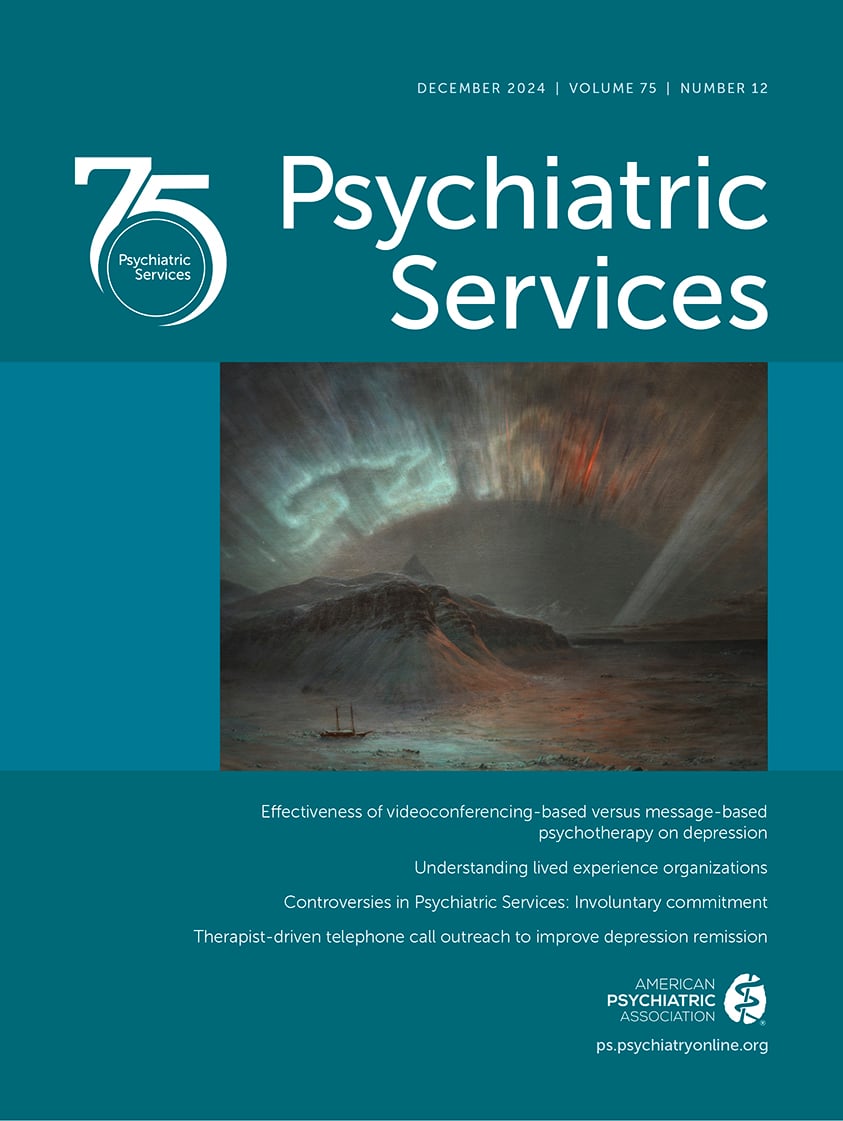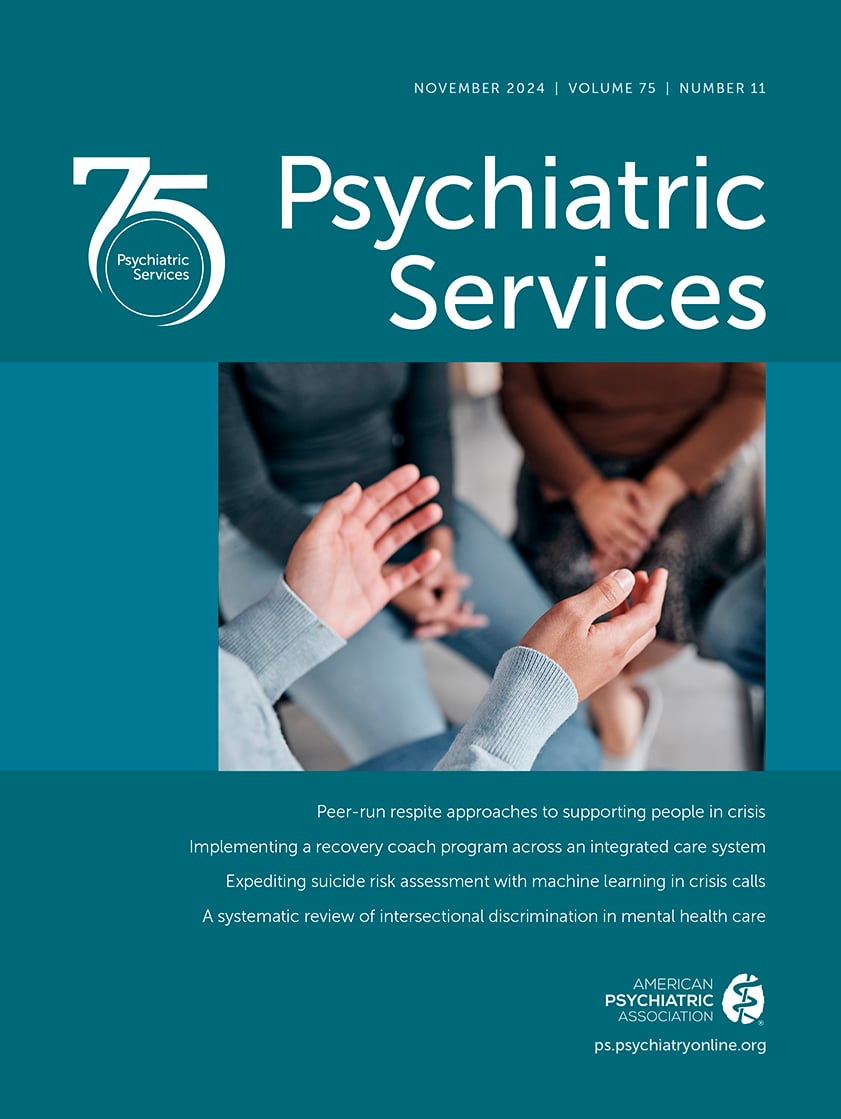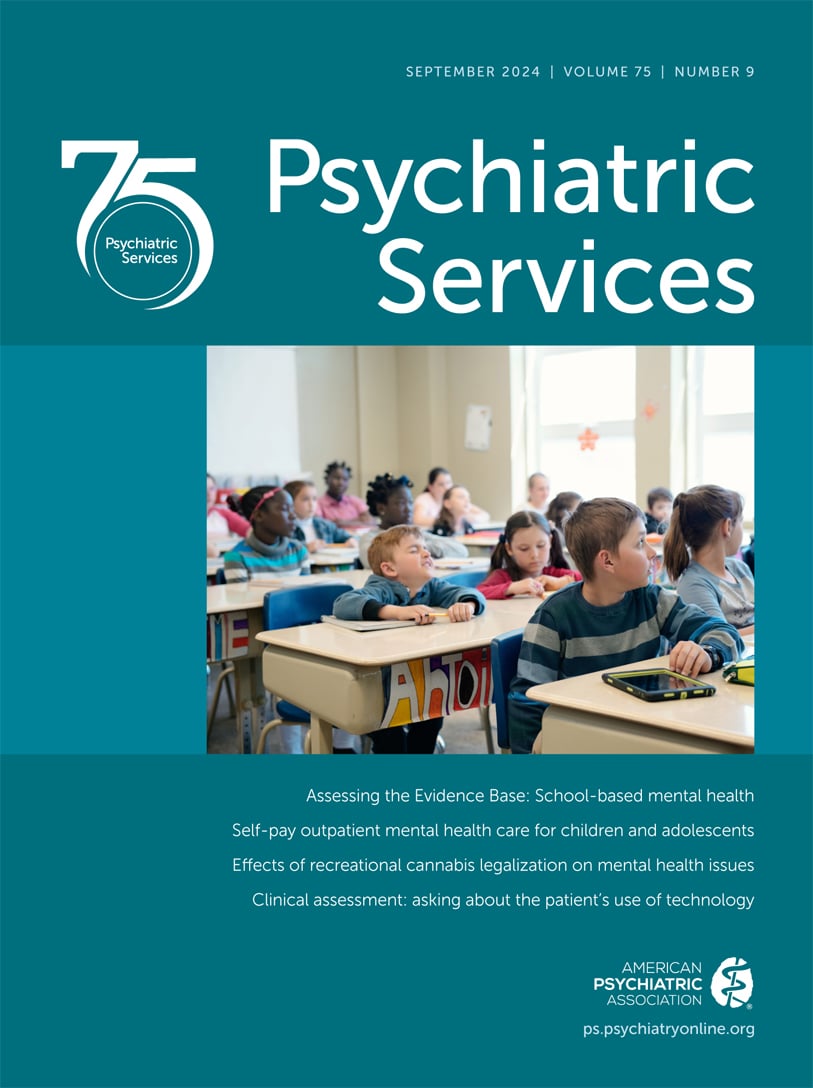Psychiatric Services
- Volume 65
- Number 4
- April 2014
Taking Issue
This Month's Highlights
Columns
Publication date: 01 April 2014
Pages406–409Patients with multiple psychiatric and medical comorbidities are common in primary care practices (PCPs), and recent health care reforms will likely lead to an increase in their numbers. PCPs need flexible, integrated mental health–primary care ...
https://doi.org/10.1176/appi.ps.201300537Publication date: 01 April 2014
Pages410–413A single criminal record can create long-term employment barriers for individuals with a serious mental illness, upending the goal of working shared by most people in recovery. This Law & Psychiatry column describes established tools that can partially ...
https://doi.org/10.1176/appi.ps.201400030Assessing the Evidence Base Series
Publication date: 01 April 2014
Pages416–428Family discouragement, overinvolvement, or high levels of expression of critical emotions can contribute to relapse among persons with serious mental illness, but the opposite seems true as well. When families participate in psychoeducation alone or with ...
https://doi.org/10.1176/appi.ps.201300266Publication date: 01 April 2014
Pages429–441Providers of mental health services have shown increasing interest in hiring peer specialists to provide a range of services and supports to persons with severe mental illnesses. In fact, many states are including supports offered by certified peer ...
https://doi.org/10.1176/appi.ps.201300244Articles
Publication date: 01 April 2014
Pages442–453Although developed early in the recovery movement, the Recovery Assessment Scale (RAS) has proven to be an effective and reliable measure of the wide spectrum of recovery, including psychological well-being, positive illness outlook, higher levels of ...
https://doi.org/10.1176/appi.ps.201300089Publication date: 01 April 2014
Pages454–460Objective This study examined low-income young adults’ use of outpatient mental health services after an inpatient mental health stay, with a focus on Medicaid enrollment lapses and public mental health safety-net coverage. Methods The sample included 1,174 ...
https://doi.org/10.1176/appi.ps.201200375Publication date: 01 April 2014
Pages461–468Objective This study sought to describe Medicaid disenrollment rates and risk factors among young adults after discharge from inpatient psychiatric treatment. Methods The sample included 1,176 Medicaid-enrolled young adults ages 18 to 26 discharged from ...
https://doi.org/10.1176/appi.ps.201300199Publication date: 01 April 2014
Pages469–475Objective This study was conducted to determine whether augmenting supported employment with cognitive remediation can improve vocational outcomes and whether augmentation is more important for participants with lower community functioning. Methods In this ...
https://doi.org/10.1176/appi.ps.201200505Publication date: 01 April 2014
Pages476–482Objective Studies of the demographic and clinical correlates of employment activity have proven useful for identifying employment assistance needs among people with severe and persistent mental illness. However, the results of prior studies remain unclear, ...
https://doi.org/10.1176/appi.ps.201300096Publication date: 01 April 2014
Pages483–489Objective When young people at risk of psychosis experience early signs of the disorder or early intervention, they may label themselves as “mentally ill.” However, empirical data related to the potentially harmful effects of self-labeling and stigma among ...
https://doi.org/10.1176/appi.ps.201300169Publication date: 01 April 2014
Pages490–497Objectives The authors compared attitudes of the U.S. general public and of mental health professionals about the competence and perceived dangerousness of people with mental health problems and the desire for social distance from them. Factors related to ...
https://doi.org/10.1176/appi.ps.201300136Publication date: 01 April 2014
Pages498–503Objective Biological explanations of psychopathology can reduce the extent to which people with mental disorders are blamed for their symptoms but can also yield prognostic pessimism—the belief that psychiatric conditions are relatively immutable. However, ...
https://doi.org/10.1176/appi.ps.201300011Publication date: 01 April 2014
Pages504–510Objective Victimization by and perpetration of domestic violence are associated with co-occurring mental and substance use disorders. Methods This study used data from the National Survey of Substance Abuse Treatment Services to examine differences in ...
https://doi.org/10.1176/appi.ps.201300005Publication date: 01 April 2014
Pages511–516Objective Few studies have addressed use of resources in police interventions involving individuals with mental illness. The time police officers spend on interventions is a straightforward measure with significant administrative weight, given that it ...
https://doi.org/10.1176/appi.ps.201300053Publication date: 01 April 2014
Pages517–522Since the 1980s, police officers in cities around the country have volunteered for crisis intervention team (CIT) training to gain skills needed to de-escalate situations involving people with serious mental illness. This study of nearly 600 Georgia ...
https://doi.org/10.1176/appi.ps.201300107Publication date: 01 April 2014
Pages523–529Objective The crisis intervention team (CIT) model is a widely implemented police-based program to improve officers’ responses to individuals with behavioral disorders. The authors examined levels of force used by officers with or without CIT training and ...
https://doi.org/10.1176/appi.ps.201300108Open Forum
Publication date: 01 April 2014
Pages530–536Crisis intervention team models that train police to handle mental health crises in the community have been applauded, but they could become a temporary trend without more research linking specific aspects of the training with behavior changes among ...
https://doi.org/10.1176/appi.ps.201200566Brief Reports
Publication date: 01 April 2014
Pages537–540Objectives This study examined rates of anticipated stigma and its impact on successful mental health referrals among elderly clients of home-delivered nutrition services who met criteria for depression. Methods Elderly clients (N=732) admitted to a home ...
https://doi.org/10.1176/appi.ps.201200530Publication date: 01 April 2014
Pages541–545Objectives The study examined attitudes of primary care patients toward mental health treatment and whether ambivalent or negative attitudes change after patients receive recommendations from their primary care physicians to seek treatment from a mental ...
https://doi.org/10.1176/appi.ps.201300064Publication date: 01 April 2014
Pages546–550Objective Internet-based treatments for early psychosis offer considerable promise, but safety and security need to be established. This study pilot tested Horyzons, a novel online treatment application that integrates purpose-built moderated social ...
https://doi.org/10.1176/appi.ps.201300078Publication date: 01 April 2014
Pages551–554Objective The aim of this research was to explore mental health clinicians’ experiences and perceptions of discussing a diagnosis of schizophrenia with their patients. The results of this research will inform a communication skills training program for ...
https://doi.org/10.1176/appi.ps.201300202Publication date: 01 April 2014
Pages555–558Objective Social cognition and interaction training (SCIT) has shown promise in improving consumers’ social cognition and functioning, in both inpatient and outpatient settings. This randomized controlled trial examined the effectiveness of SCIT among ...
https://doi.org/10.1176/appi.ps.201300146Publication date: 01 April 2014
Pages559–562Objective The study assessed survivors of Oklahoma City’s 1995 bombing seven years postdisaster to identify long-term mental health service use. Methods Psychiatric disorders and disaster-related variables were assessed for 99 survivors at seven years ...
https://doi.org/10.1176/appi.ps.201200579Letters
News and Notes
Past Issues
View Issues Archive
Vol. 75 | No. 12

Vol. 75 | No. 11

Vol. 75 | No. 10
